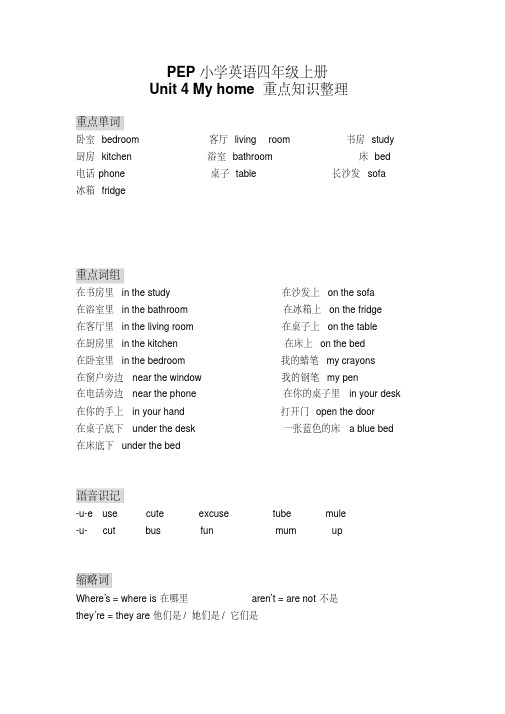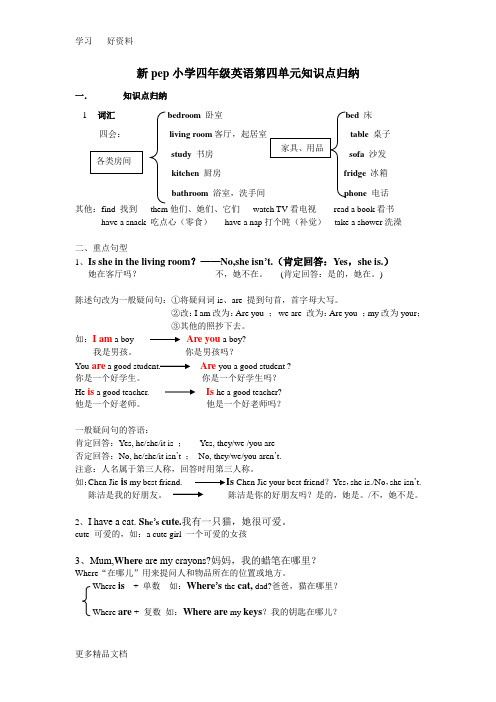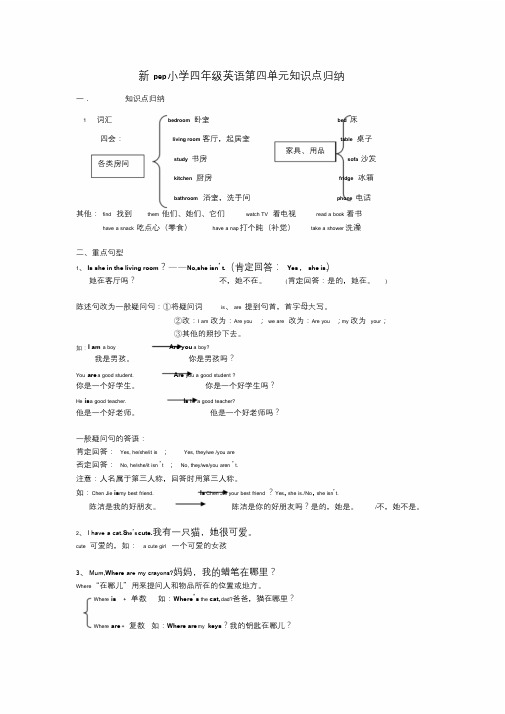XX四年级英语上册第四单元知识点总结(新PEP)
- 格式:docx
- 大小:13.67 KB
- 文档页数:3

PEP小学英语四年级上册Unit 4 My home 重点知识整理重点单词卧室bedroom 客厅living room 书房study 厨房kitchen 浴室bathroom 床bed 电话phone 桌子table 长沙发sofa冰箱fridge重点词组在书房里in the study 在沙发上on the sofa在浴室里in the bathroom 在冰箱上on the fridge在客厅里in the living room 在桌子上on the table在厨房里in the kitchen 在床上on the bed在卧室里in the bedroom 我的蜡笔my crayons在窗户旁边near the window 我的钢笔my pen在电话旁边near the phone 在你的桌子里in your desk 在你的手上in your hand 打开门open the door在桌子底下under the desk 一张蓝色的床 a blue bed 在床底下under the bed语音识记-u-e use cute excuse tube mule-u- cut bus fun mum up缩略词Where’s = where is 在哪里aren’t = are not 不是they’re = they are 他们是/ 她们是/ 它们是重点句子1. Where’s the cat? 猫在哪里?2. Where is she? 她在哪里?3. Is she in the living room? 她在客厅吗?--Yes, she is. 是的,她在。
--No, she isn’t. 不,她不在。
4. Is she in the kitchen? 她在厨房吗?--Yes, she is. 是的,她在。
--No, she isn’t. 不,她不在。
5. Where’s my pen? 我的钢笔在哪里?6. Is it in your hand? 它在你的手里吗?--Yes, it is. 是的,它在。

Unit My home一、核心词汇1.常见表示家庭居室的单词:bedroom卧室living room客厅;起居室study书房kitchen厨房bathroom浴室;洗手间2.常见表示生活物品的单词:bed床phone电话table桌子sofa长沙发fridge冰箱3.常见描述生活中动作的短语:watch TV看电视read a book读书4.描述方位的短语:near the phone在电话旁边under the table在桌子下面on the table 在桌子上二、了解词汇1.常见描述生活中动作的短语:have a snack吃零食have a nap小睡一会儿take a shower洗澡2.其他:find找到them他(她、它)们三、核心句型1.— Where is she?她在哪儿?— She is in the kitchen.她在厨房。
解读:此句型用来询问某人或某物的位置。
拓展:若主语为复数,则此句应改为“— Where are they?— They are in the kitchen.”。
其他可以表示方位的介词有in/on/under/near 等。
2.They’re in the door.它们在门上。
解读:此句型用来表达某人或某物在某地。
句型结构为“主语+be动词(is/are)+介词短语.”拓展:若主语为单数,则此句应改为“It’s in the door.”。
3.— Is she in the living room?她在客厅里吗?— No, she isn’t.不,她不在。
解读:此句是一般疑问句,用来判断某人或某物是否在某地。
拓展:当主语为复数时,则此句应改为“Are they+介词短语?”“ Yes, they are./No, they aren’t.”。
4.Open the door, please.请开门。
解读:此句型用来提出行动建议。
四、了解句型1.She’s in the kitchen.她在厨房里。

四年级英语上册(PEP)Unit 4 My home必备知识点四年级英语上册(PEP)Unit 4 My home的必备知识点主要包括词汇、句型、语音和日常交际用语等方面。
以下是对这些知识点的详细归纳:一、词汇1. 家居房间类:bedroom(卧室)living room(客厅)study(书房)kitchen(厨房)bathroom(浴室/卫生间)2. 家具家电类:bed(床)phone(电话)table(桌子)sofa(沙发,注意其复数形式为sofas)fridge(冰箱)3. 其他词汇:find(找到,注意其过去式为found)them(他们,宾格形式)二、句型询问人或物品所在位置的句型:问句:Where is + 人/物品(单数)?答语:人/物品 (单数)+ is + 表示地点的介词短语。
举例:Where is the pen? (钢笔在哪里?)It's in the bag. (它在包里。
)问句:Is + 人/物品(单数)+ 表示地点的介词短语?答语:Yes, he/she/it is. / No, he/she/it isn't.举例:Is she in the living room? (她在客厅里吗?)No, she isn't. (不,她不在。
)询问复数物品或人物所在位置的句型:问句:Where are + 人/物品(复数)?答语:人/物品(复数)+ are + 表示地点的介词短语。
举例:Where are the keys? (钥匙在哪里?)They're on the fridge. (它们在冰箱上。
)问句:Are + 人/物品 (复数)+ 表示地点的介词短语?答语:Yes, they are. / No, they aren't.举例:Are they on the table? (它们在桌子上吗?)No, they aren't. They're in the door. (不,不在。

新pep 小学四年级英语第四单元知识点归纳一. 知识点归纳1 词汇bedroom 卧室床四会: living room 客厅,起居室table 桌子study 书房 sofa 沙发 kitchen 厨房 冰箱bathroom 浴室,洗手间 电话其他:find 找到 them 他们、她们、它们 watch TV 看电视 read a book 看书 have a snack 吃点心(零食) have a nap 打个盹(补觉) take a shower 洗澡二、重点句型1、Is she in the living room ?——No,she isn ’t.(肯定回答:Yes ,she is.) 她在客厅吗? 不,她不在。
(肯定回答:是的,她在。
)陈述句改为一般疑问句:①将疑问词is 、are 提到句首,首字母大写。
②改:I am 改为:Are you ; we are 改为:Are you ;my 改为your ; ③其他的照抄下去。
如:I am a boy Are you a boy?我是男孩。
你是男孩吗?You are a good student. Are you a good student ?你是一个好学生。
你是一个好学生吗?He is a good teacher. Is he a good teacher?他是一个好老师。
他是一个好老师吗?一般疑问句的答语:肯定回答:Yes, he/she/it is ; Yes, they/we /you are否定回答:No, he/she/it isn ’t ; No, they/we/you aren ’t.注意:人名属于第三人称,回答时用第三人称。
如:Chen Jie is my best friend. Is Chen Jie your best friend ?Yes ,she is./No ,she isn ’t. 陈洁是我的好朋友。

(新版)PEP四年级英语上册第四单元重点单词和句型归纳第一篇:(新版)PEP四年级英语上册第四单元重点单词和句型归纳Unit 4 My home(我的家)词汇:study 书房bathroom 浴室bedroom 卧室kitchen 厨房fridge冰箱livingroom 起居室(客厅)phone电话bed床sofa 长沙发table桌子find 找到them 他(她、它)们(必须能听写)homeschoolclassroomdeskchairwindowbed 家学校教室课桌椅子窗户床句型:1、Where’s Amy? Amy在哪里?in the study?她在书房吗?she.是的,她在。
(肯定回答)she.不,她不在。
(否定回答)2、Wherethe 钥匙在哪里?on the table?它们在桌子上吗?① 是的,它们在。
(肯定)② 不,它们不是。
(否定)They’re the door.它们在门里。
3、3、in the living room?她在起居室里吗?, she.不,她不在。
She’s(=She is)in the kitchen.她在厨房里。
4、in your desk?它在你的桌箱里吗?it 是的,它在。
, it 不,它不在。
5、Open the door,please.请开门Ok.好的第二篇:(新版)PEP四年级英语上册第五单元重点单词和句型练习Unit 5 Dinner’s ready(晚餐准备好了)一、请把下列单词翻译成中文。
juice二、请把下列句子翻译成中文。
1、What would you like for dinner?I’d like some rice and soup, please.译;2、I’m hungry.What’s for dinner? 译;3、Would you like some beef? Yes, please.译;4、What would you like?I’d like some soup and bread,please.译;5、Can I have a knife and fork,please?Yes,but try chopsticks fornoodles.译;6、Now let’s try it.译;7、Ok,here you are.译;8、Dinner’s ready.Help yourself.译;9、Here are today’s specials.10、I can use chopsticks.译;译;11、Pass me the chopsticks please.译;12、Cut the vegetables.译;Pass me the bowl译;第三篇:PEP小学英语四年级上册第四单元教案PEP小学英语四年级上册第四单元教案第一课时教学内容:A Let’s learn Let’s do教学目标:1.能听懂、会说:This is my home.并能简单描述自己的房间。

新pep 小学四年级英语第四单元知识点归纳一.知识点归纳1 词汇bedroom 卧室bed 床四会:living room 客厅,起居室table 桌子各类房间家具、用品study 书房sofa 沙发kitchen 厨房fridge 冰箱bathroom 浴室,洗手间phone 电话其他:find 找到them 他们、她们、它们watch TV 看电视read a book 看书have a snack 吃点心(零食)have a nap 打个盹(补觉)take a shower 洗澡二、重点句型1、Is she in the living room?——No,she isn’t.(肯定回答:Yes,she is).她在客厅吗?不,她不在。
(肯定回答:是的,她在。
)陈述句改为一般疑问句:①将疑问词is、are 提到句首,首字母大写。
②改:I am 改为:Are you ;we are 改为:Are you ;my 改为your;③其他的照抄下去。
如:I am a boy Are you a boy?我是男孩。
你是男孩吗?You are a good student. Are you a good student ?你是一个好学生。
你是一个好学生吗?He is a good teacher. Is he a good teacher?他是一个好老师。
他是一个好老师吗?一般疑问句的答语:肯定回答:Yes, he/she/it is ;Yes, they/we /you are否定回答:No, he/she/it isn ’t ;No, they/we/you aren ’t.注意:人名属于第三人称,回答时用第三人称。
如:Chen Jie is my best friend. Is Chen Jie your best friend ?Yes,she is./No,she isn’t.陈洁是我的好朋友。
Unit Myhome一、核心词汇1.常见表示家庭居室的单词:bedroom卧室livingroom客厅;起居室study书房kitchen厨房bathroom浴室;洗手间2.常见表示生活物品的单词:bed床phone电话table桌子sofa长沙发fridge冰箱3.常见描述生活中动作的短语:watchTV看电视readabook读书4.描述方位的短语:nearthephone在电话旁边underthetable在桌子下面onthetable在桌子上二、了解词汇1.常见描述生活中动作的短语:haveasnack吃零食haveanap小睡一会儿takeashower洗澡2.其他:find找到them他(她、它)们三、核心句型1.— Whereisshe?她在哪儿?— Sheisinthekitchen.她在厨房。
解读:此句型用来询问某人或某物的位置。
拓展:若主语为复数,则此句应改为“—Wherearethey?—Theyareinthekitchen.”。
其他可以表示方位的介词有in/on/under/near 等。
2.They’re inthedoor.它们在门上。
解读:此句型用来表达某人或某物在某地。
句型结构为“主语+be动词(is/are)+介词短语.”拓展:若主语为单数,则此句应改为“It’sinthedoor.”。
3.— Issheinthelivingroom?她在客厅里吗?—No,sheisn’t.不,她不在。
解读:此句是一般疑问句,用来判断某人或某物是否在某地。
拓展:当主语为复数时,则此句应改为“Arethey+介词短语?”“Yes,theyare./No,theyaren’t.”。
4.Openthedoor,please.请开门。
解读:此句型用来提出行动建议。
四、了解句型1.She’sinthekitchen.她在厨房里。
解读:此句型用来表达某人或某物在某地。
She’s是sheis的缩写形式。
XX四年级英语上册第四单元知识点总结
(新PEP)
Unit4
myhome看到“我的家”你想到第四单元的知识有哪些?
单词:
房间类:bedroomlivingroomstudykitchenbathroom
房间物品类:phonetablebedsofafridgefind找到them 他们
Let’sspell:
u-e[ju:]use使用cute可爱的excuse原谅,道歉tube 管道mule骡子
u[ʌ]cut切us我们fun开心up向上bus公共汽车mum妈妈duck鸭
句型:
猜测人物所在位置(单数):Issheinthelivingroom?yes,sheis./No,sheisn’t.
猜测物品位置(复数):Aretheyonthetable?yes,theyare./No,theyaren’t.They’reinthedoor.
语法点:1.is//are开头的句子属于一般疑问句,回答是yes或者no,然后根据句子的开头进行颠倒变化。
询问物品位置(复数):wherearethekeys?They’
reinthedoor.
She’sinthekitchen.openthedoor,please.
Be的用法口诀
我用am,你用are,is连着他,她,它;
单数名词用is,复数名词全用are。
变疑问,往前提,句末问号莫丢弃。
变否定,更容易,be后not莫忘记。
疑问否定任你变,句首大写莫迟疑。
短语:
1.地点类:inthestudy在书房inthekitchen在厨房inthebathroom在浴室
inyourdesk在你的课桌里inyourhand在你手里onthetable在桌子上
underthetable在桌子下onthefridge在冰箱上nearthephone在电话旁边onthebed在床上
2.动作类:watchTV看电视readabook看书haveasnack 吃点心haveanap睡一会儿
openthedoor开门lookat看Gotothelivingroom.watchTV去客厅,看电视
Gotothestudy.Readabook去书房,读书Gotothekitchen.Haveasnack去厨房,吃零食
Gotothebedroom.Haveanap去卧室,睡觉
Gotothebathroom.Takeashower.去浴室,洗澡
答语、答句
1.------Issheinthelivingroom?------No,sheisn’t./yes,sheis.
2.------Aretheynearthephone?------No,theyaren’t./yes,theyare.
3.------whereisthecap?------It’sonthebed.
4.------wherearethekeys?
------Aretheyonthetable?------No,theyaren’t.They’reinthedoor.
5.------wherearethekeys?------They’reonthefridge.
6.------openthedoor,please.------ok.
7.------Issheinthestudy?-------No,sheisn’t./yes,sheis.
8.------Isitinyourhand?------yes,itis!/No,itisn’t.。